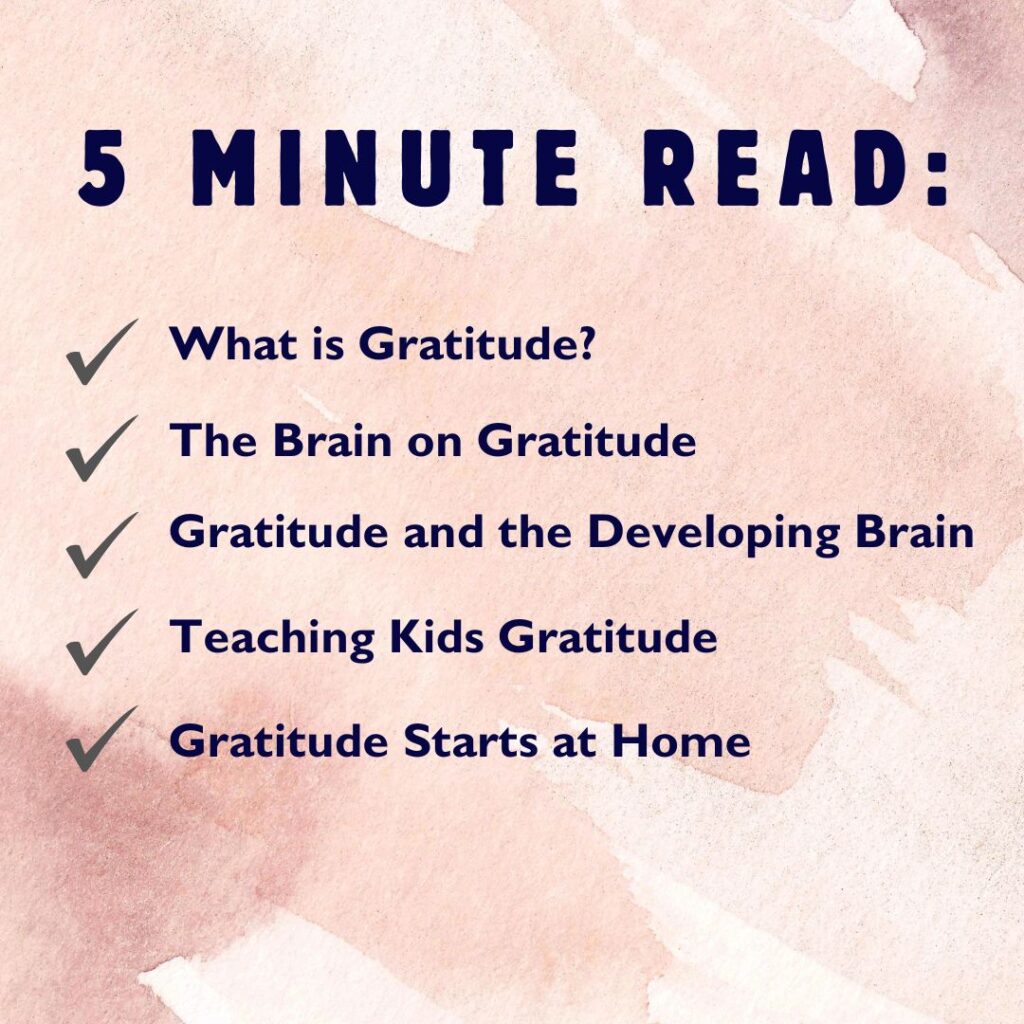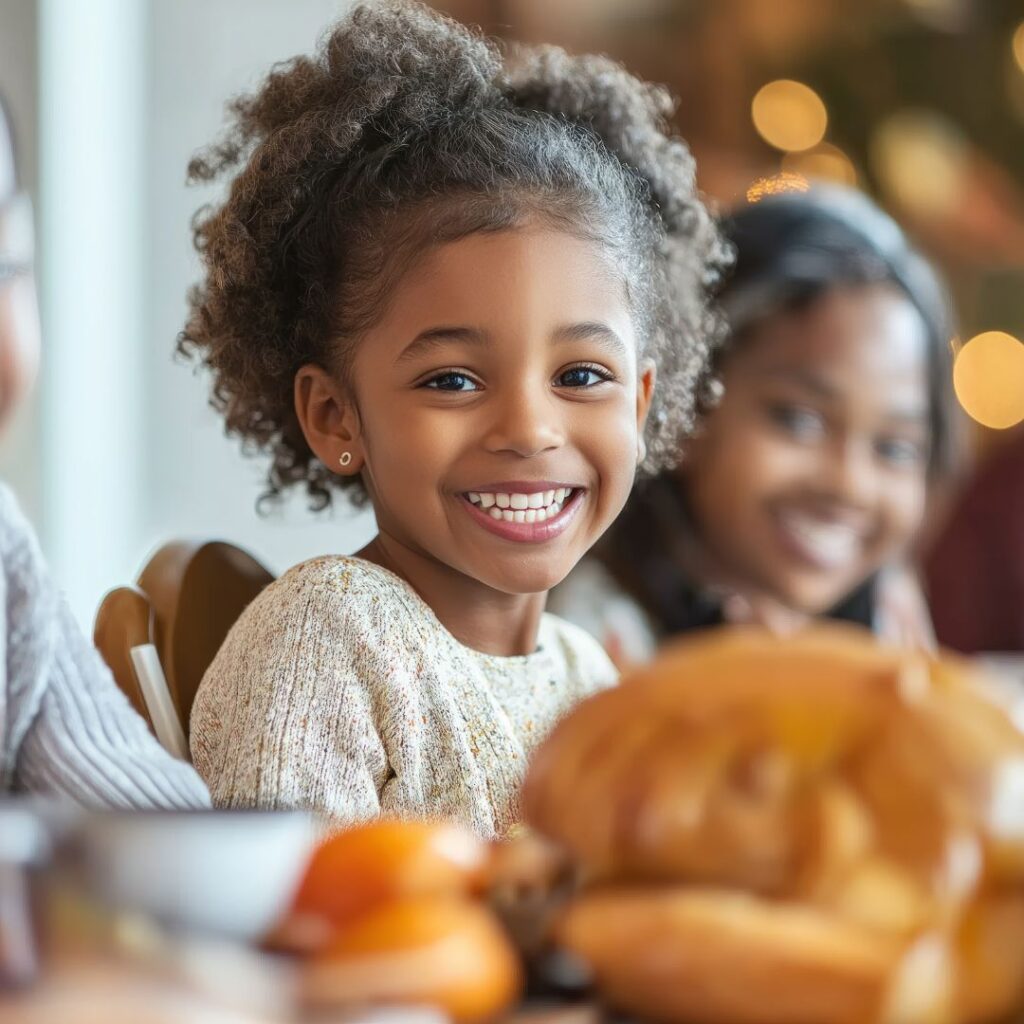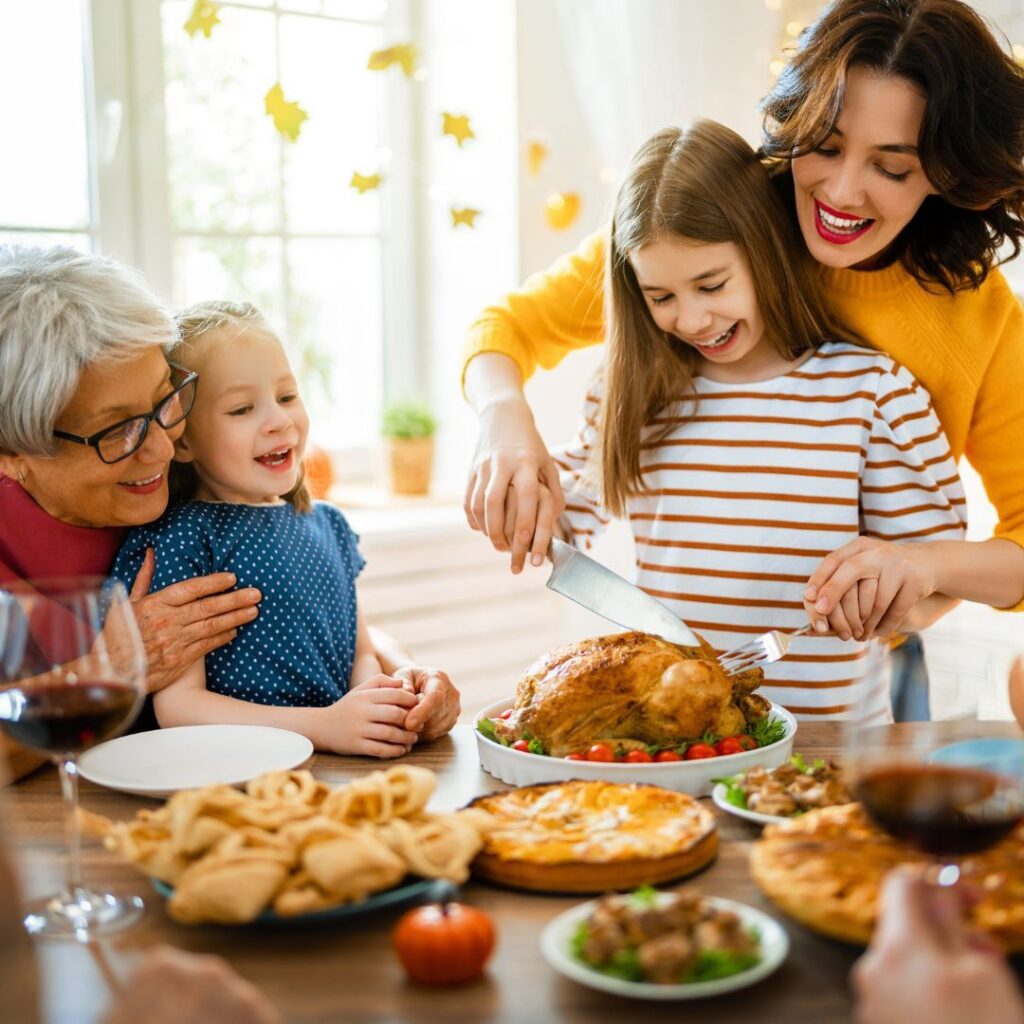Family Gratitude CHallenge
Join our free 14-Day Family Gratitude Challenge this holiday season!
Happy Little moments





Teaching Kids Gratitude: The Power of Thankfulness in Childhood
Have you ever wondered why teaching kids gratitude is important? Or wondered why we’re always telling our kids to say “thank you?” Or telling them to appreciate what they have? I’ll admit, when I first became a parent, a part of me wondered: Am I merely instilling these habits to appear like a good parent or simply because it’s how I was raised?
It turns out, there’s a whole lot of science behind the importance of gratitude, especially when it comes to kids. The science of gratitude and how it influences our brains is fascinating. And it’s especially interesting when we’re dealing with a developing brain. And there’s a whole lot of evidence to back up teaching our kids to be thankful.
There’s a lot to cover here so let’s get into it!

What is Gratitude?
Gratitude more than just saying “thanks” when someone does something nice for you. Gratitude is about recognizing and appreciating the good things in life, big and small.
Gratitude is a powerful emotion that makes you appreciate your life, the people around you, all of your blessings, and makes you feel more fulfilled and joyful. It’s a mindset, a way of looking at the world that can have some pretty amazing effects on our brains and bodies.
And it can especially give our children an incredible mindset shift and positive way of looking at the world around them.
What Are the Benefits of Gratitude?
I’ve recently been challenged by a colleague to write a few thank you cards per week. The simple act of writing out specific things that others have done for me has given me an incredible gift. And it’s also a gift to others when they receive those note cards.
For one, writing thank you notes requires me to think about who I know, who I’ve known, and how those amazing people influence my life. This automatically redirects my brain to the positive qualities of the people around me.
Which leads me to my next point…
The Brain on Gratitude
You know how exercise is good for your body? Gratitude is like a workout for your brain – especially the parts that deal with positive emotions. When we practice gratitude, our brains release dopamine and serotonin, which in turn, make us very happy! And best of all, being happy attracts more happiness.
These “feel-good” chemicals don’t just make us feel good in the moment–they can actually help create lasting changes in our brain. The more we train our brains to be grateful, the easier it is to direct our brains toward things we are thankful for and the positive things that happen in our lives.
Being Thankful Causes Less Stress
Here’s a surprising fact: gratitude can actually help bring down our stress hormones, such as cortisol. Additionally, when we focus on what we’re thankful for, our brain tends to produce less of these stress-inducing chemicals.
For our children, who are still figuring out the world, this is really a game-changer. Being a grateful person actually gives you tools to bring down your own stress levels in a natural and healthy way.
Pretty cool, right?

Kids Need Gratitude Today More Than Ever
Unfortunately, our world is not set up for gratitude to be inherent in our children. There’s a few reasons for this:
1). Instant gratification has become the expectation. Our children are used to getting things right now. Therefore, patience for things that used to take time is becoming shorter and shorter, which also makes us unhappier.
2). The rise of social media makes comparisons to others nearly constant. We used to only see what our neighbors were doing and the cool toys they had. Now, we have the luxury of comparing ourselves to almost anyone on the planet. We have much higher expectations for ourselves than ever.
Needless to say, our brains weren’t set up for that.
3). We are both simultaneously more connected and less connected to each other now more than ever. While we are connected to everyone via our technology, we often don’t see people as often as we once did. Sadly, this disconnectedness from one another also tends to breed less appreciation for one another.
Building our Gratitude Muscle also Builds our Resilience Muscle
Unfortunately, life’s journey isn’t always easy, and we need to teach our children how to weather the storms that come their way. Because storms will come in life.
Thankfully, (no pun intended!), gratitude is like a secret weapon in building resilience. When we teach our children to focus on the good things in their lives, even during the hard times, they are much better equipped to make a comeback from their setbacks.
Ultimately, people who express gratitude have a more positive outlook on life and are better able to handle stress.
By teaching our kids to be grateful, we are giving them an important tool to face life’s challenges. To be clear, we’re not teaching our children to ignore their problems. However, we are directing our children’s brains toward the positive things around them that will help them persevere during the hard times that come their way.

Thankfulness Boosts Confidence
Did you know that confidence and gratitude are linked? In a world that is obsessed with building kids’ confidence and self-esteem, why are we not equally obsessed with teaching them to be grateful for the amazing things in their lives?
It turns out that when children are taught to appreciate others and the blessings in their lives, they’re also more likely to appreciate their own good qualities within themselves.
Gratitude Improves Relationships
Expressing our gratitude doesn’t just benefit us. It also helps build our relationships with others. When children show that they are grateful to others, it strengthens their connections with family members, friends, and teachers.
Basically, through gratitude, our children get stuck in a positive feedback loop – the more thankful they are, the more positive interactions they tend to have, which gives them more to be thankful for.
Clearly, being grateful to others translates to having better friendships, better family dynamics, and even better relationships with teachers, peers, and colleagues.
Gratitude and the Developing Brain
For kids, whose brains are still developing, this is really exciting. By encouraging our children to express gratitude, we’re helping to shape their developing brains in positive ways.
The Link Between Gratitude and Academic Performance
However, it’s not that gratitude magically makes kids smarter. Rather, gratitude fosters a positive attitude towards learning and school, which promotes a growth mindset and helps children do better in class.

Gratitude's Impact on Mental Health
In today’s world, many children are already plagued by anxiety and depression. Teaching kids gratitude gives hope to many of these children. Research has shown that regularly practicing gratitude reduces anxiety and depression in children and adults.
By teaching kids to focus on the positive aspects of their lives, we’re giving them a powerful tool for maintaining good mental health.
How to Nurture Gratitude in Kids: Fun and Easy Strategies
Now that you know just how important teaching kids gratitude is, how do you begin to teach this quality to your children? Here’s some fun and easy ways to incorporate it into your own family culture.
If you’re really ready for a family transformation, check out my free 14-Day Family Gratitude Challenge!
- Strengthen family bonds with daily gratitude activities
- Discover simple ways to recognize the blessings in your lives
- Fill your holiday season with more love, joy, and togetherness
Click HERE to learn more!
Here are just a few ideas on gratitude to get you and your family started!
Teaching Kids Gratitude
1). Create a Gratitude Jar
Decorate a large jar and keep it in a central location in your home. Encourage everyone to write down things they’re grateful for on small slips of paper and add them to the jar. Then, once per week, sit down as a family and read them together!
2). Start a Weekly Gratitude Practice
Pick one day per week as your family’s gratitude day. At dinner or bedtime, have each family member share something they’re grateful for from the week. Making this a regular family practice helps make gratitude a habit and brings you closer as a family.3. Gratitude Scavenger Hunt: Turn Thankfulness into an Adventure
3). Create a Scavenger Hunt
Give your family prompts such as “Find something that makes you smile” or “Discover something in nature you’re thankful for.” This turns gratitude into a fun, interactive game that gets kids thinking creatively about what they appreciate.
4). Do Thank-You Note Challenge
Challenge your kids (and yourself!) to write at least one thank-you note per week to someone who has made a difference in their life. It could be a teacher, friend, family, or even a church member or the librarian. This practice not only expresses gratitude but also strengthens social connections.
5). Gratitude Photography: Capturing Thankfulness
For the tech-savvy kids, encourage them to take photos of things they’re grateful for throughout the week. At the end of the week, have a family slideshow where everyone shares their photos and why they’re thankful for what they captured.
Overcoming Challenges: When Gratitude Doesn't Come Easy
Let’s be real for a moment – teaching gratitude isn’t always a walk in the park. Sometimes kids (and adults!) struggle with finding things to be thankful for, especially during hard times. Here are some tips for navigating those challenges:
1). Lead by Example
Kids learn more from what we do than what we say. Make a point of expressing your own gratitude regularly, even for small things. “I’m so thankful for this warm cup of coffee on a cold morning!” or “I really appreciate how you helped set the table without being asked.” Your example will set the tone.
2). Acknowledge Difficult Feelings
It’s important to validate kids’ feelings, even when they’re negative. You can say something like, “I know you’re feeling frustrated right now, and that’s okay. When you’re ready, let’s try to think of one small thing we can be grateful for, even in this tough situation.”
3). Make It Age-Appropriate
Tailor your gratitude activities to your child’s age and interests. Younger kids might enjoy drawing pictures of things they’re thankful for, while older kids might prefer keeping a gratitude journal.
4). Celebrate Small Wins
Encourage kids to be grateful for small achievements and everyday occurrences. Did they tie their shoes by themselves? Finish a challenging homework assignment? These are all opportunities for gratitude.

Teaching Kids Gratitude Starts at Home
In conclusion, I hope you have a clearer understanding of the science behind gratitude and why encouraging our kids to be grateful is so important. Teaching kids gratitude increases happiness and resilience, improves social relationships, and improves academic performance. Gratitude truly is a powerful emotion that can change the brain in many positive ways.
As you’re teaching your child about gratitude, remember that it isn’t about forcing kids to be grateful. It’s about making children aware of the good things in their lives. Gratitude takes practice, whether you’re an adult or a child, but the benefits of gratitude are worth the effort.
As we are parenting our children, let’s make gratitude a common family value. Let’s start this gratitude journey together and start raising our children to be happier, more positive, and more resilient.
